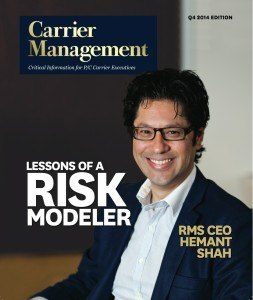The Q4 2014 edition of Carrier Management magazine, broadly themed around reinsurance and risk models, includes a group of articles profiling three members of the new crop of reinsurers in Bermuda. And tucked inside one of those articles is this fun fact reported by one of the CEOs: “More than 10 percent of the employees who worked at a reinsurance company known as F&G Re became CEOs or presidents of companies at some point in their career.”
If the statistic shared by John Berger doesn’t seem remarkable, consider these related facts:
- Thirty-one years after F&G Re’s launch, Berger, a founding member of the startup back then, is now CEO of Third Point Re—marking his fourth stint as CEO of a reinsurer.
- Dwight Evans, another founding member of F&G Re, is rumored to be involved with another new reinsurance startup, which like Third Point will be associated with a hedge fund.
- John Rathgeber, who joined the F&G Re team years later, is now CEO of Watford Re—yet another hedge-fund reinsurer.
- F&G Re was only in business for 15 years, and 10 of the 95 employees over that period became president or CEOs, according to Berger.
If you’re not old enough to remember the movie “Rocky,” you may not even remember F&G Re, which started as a reinsurance unit of U.S. F&G in 1983 and was ultimately rolled into St. Paul when the Minneapolis insurer acquired U.S. F&G in 1998. If you search the Internet for more F&G Re history, you might just stumble on a 30-year reunion video on YouTube opening with the “Rocky” theme, “Gonna Fly Now,” playing in the background as a series of executive photos pop up on the screen: F&G Re President Paul Ingrey, who would later become chairman of Arch Capital; Vice President Berger; Senior Vice President James Stanard, who was later the founder of RenaissanceRe…
The roster is a Who’s Who of the reinsurance industry.
Was there something in the water at F&G Re, or in the culture? What is it that placed all these executives on the path to the C-suite of successful companies—in some cases, many times over? And what keeps some of them still flying high now, innovating and pursuing new startup opportunities at a time when a more relaxing option might be retirement?
The video starts with this quote from Ingrey, presumably something he said at some early date in F&G Re’s history: “My philosophy for F&G Re encompasses being able to respond quickly to the marketplace and to use the combination of imagination and technical expertise to develop underwriting solutions for our clients.”
Perhaps that doesn’t answer our culture question directly, but imagination and technical expertise continue to shine through in the new hedge-fund reinsurer startups. Three are profiled in the fourth-quarter magazine: Berger’s Third Point Re, Rathgeber’s Watford Re and Hamilton Re, headed by CEO Kathleen Reardon.
 Imagination and technical expertise are also part of the history of a firm that started taking shape five years after F&G Re was founded—risk modeler RMS—whose CEO, Hemant Shah, pictured on our magazine cover, describes the Silicon Valley-type culture of innovation that he’s infused in his company.
Imagination and technical expertise are also part of the history of a firm that started taking shape five years after F&G Re was founded—risk modeler RMS—whose CEO, Hemant Shah, pictured on our magazine cover, describes the Silicon Valley-type culture of innovation that he’s infused in his company.
Then there’s the other side of the culture question—one that corporate historian Russ Banham probes in his look at the history of Fireman’s Fund. A parade of CEOs heading for the exits has experts wondering what’s wrong with the culture there, or whether an incompatible culture at the parent company may ultimately jeopardize the future of an iconic brand.
This edition also includes more information on risk models, including an article written by an iconic figure in the catastrophe modeling sector, Karen Clark, on the development of open platforms, as well as highlights of the Rendez-Vous de Septembre in Monte Carlo.





















 Property and Casualty Insurance Trends for 2025
Property and Casualty Insurance Trends for 2025  Weak La Nina Expected in the Central Region of the U.S. This Winter: NWS
Weak La Nina Expected in the Central Region of the U.S. This Winter: NWS  Insurance Carrier Employees Are Bored; Most Boring Rankings Published
Insurance Carrier Employees Are Bored; Most Boring Rankings Published  Soft Market Ahead? The Role of Digital Transformation for E&S Insurers
Soft Market Ahead? The Role of Digital Transformation for E&S Insurers 


